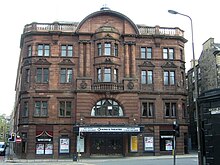King's Theatre, Edinburgh

King's Theatre in 2009
|
|
| Address | 2 Leven Street, EH3 9LQ Edinburgh Scotland |
|---|---|
| Owner | City of Edinburgh |
| Operator | Festival City Theatres |
| Capacity | 1350 |
| Current use | Theatre |
| Construction | |
| Opened | 1906 |
| Architect | James Davidson (exterior) and J. D. Swanston (interior) |
| Website | |
| www |
|
The King's Theatre was opened in 1906 and stands on a prominent site on Leven Street in Edinburgh. It is one of Scotland's historic and most important theatres. It plays a vital role in today's theatre industry as much as it has done in its 100 years of service to Edinburgh theatre patrons.
The King's is famous for being a venue belonging to the theatre empire Howard & Wyndham. The theatre was originally commissioned by the Edinburgh Building Company, which was a group of local businessmen. The business group was led by Robert C. Buchanan. The King's was built as a rival to the successful Royal Lyceum Theatre which had been established for over twenty years. Buchanan was experienced in the industry as he already managed a large number of provincial variety theatres, however this was his most ambitious project yet. A memorial stone was laid on 6 August 1906, and copies of the current newspaper and coins were buried underneath. During the building's construction, the owners experienced financial troubles, and before the project was complete, the business group transferred their rights to the King's Theatre Company. It was formed by William Stewart Cruikshank, a builder, whose firm constructed the theatre and he subsequently became a major shareholder. Buchanan was managing director and he took on the day-to-day running of the King's. Buchanan was soon ousted by Cruikshank's son, A. Stewart Cruikshank, who was a dynamic businessman with a soft spot for theatre.
The building opened to audiences for the first time on 8 December 1906, with a festive production of Cinderella with Violet Englefield as the Prince and Phyllis Dare as Cinderella. The theatre began a successful career as a variety touring house with visits from Carl Rosa Opera and Richard D'Oyly Carte's company. Cruikshank later realised that his theatre was at a disadvantage by not being part of a mainstream circuit. In 1928 he merged his theatre with Howard and Wyndham, and also became chairman of the company. The King's closed during the summer, which was a common practice in theatres up and down the country.
In 1934 A. Stewart Cruikshank decided it would be worth experimenting with a summer season in Edinburgh along the lines of seaside entertainment. The show, known as The Half Past Eight, had already been a great success at the theatre's namesake in Glasgow, where comic Jack Edge performed to full houses for fourteen weeks. Edge was brought over to Edinburgh to open the show, but with meagre audiences it flopped and lasted just six weeks. Howard and Wyndham brought in Charles and Ilona Ross to produce their winter pantomimes. Charles Ross knew that closing the theatre for the summer was wasting an opportunity, and he wanted to revive the summer show which had failed previously. Cruikshank was at first sceptical, but in 1937 he gave in, and gave the show four weeks to succeed or he would close it. Ross could not find a big star to front the show, and it seemed it was to fail once again. He eventually tracked down a young fairly unknown comic called Dave Willis. Willis was just what Ross had been looking for. The Half Past Eight show opened on 31 May 1937, and was billed as 'An after dinner light revue of song, dance and laughter - also starring Cliff Harley, Florence Hunter and the Charles Ross Girls'. At first, only a few hundred came to see the show, and by the end of the third week Cruikshank was about to close the production. What happened next was not to be expected. News of the show spread by word of mouth and by the end of the following week, the King's was packed nightly with standing room only,. The program changed every week. There were big opening and finale numbers with the dancers in sequinned and feathered dresses, and Dave Willis was a hard working individual appearing throughout most of the show. By 1941, the show had stretched to twenty-eight weeks. When Willis moved to open a Glasgow version of the show, Harry Gordon took over. Subsequent stars were Stanley Baxter, Rikki Fulton and Jimmy Logan.
...
Wikipedia
